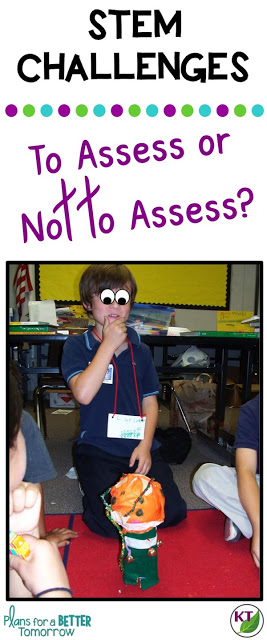The main thing I want to put forward today is that we shouldn’t assess for sake of assessing or out of habit. Assessments should always be thoughtful and serve a worthy purpose. So, before making any decisions about assessments, ask yourself why are you doing STEM challenges in your classroom? What do you hope to achieve? What are your goals?
My Goal List (more or less in order of importance):
– I want students to develop problem-solving and critical thinking skills.
– I want to truly challenge students, so they will encounter frustration and potentially failure. Then, I’ll facilitate the analysis & fixing of failure points. Ultimately, I’m hoping these experiences lead students to not to fear failure, become more resilient and adopt a growth mindset.
– I want to provide opportunities to demonstrate creativity.
– I will facilitate, not lead, so students know I believe in their ability to solve problems without my help, and they will build confidence and self-reliance.
– I want students to practice working collaboratively, making their ideas heard, and being willing to compromise and/or accept when the group wants to move in a different direction.
– I want students to make connections to how STEM skills are used to solve real-world problems.
– I want to address Next-Gen Science Standards.
Should we Assess?
Once you have your list, you can determine if you want to assess, and if so, how you want to go about it. My goals would be undermined by assessing the design itself after a single iteration, so I simply don’t do that. (More on this in a bit.)
Can I just ask, don’t we have enough assessments already?! I’m not eager to add new ones. However, I understand that we want to make sure our students are accountable for participating, and in some cases, we need to justify use of class time for something that looks to the lay person like “fun”.
Regarding participation, I’ve only encountered two issues that led to issues with participation: 1) group size was set too large (my mistake) and there wasn’t a way to actively participate for all in the group. 2) Someone shuts down because their idea wasn’t chosen. This is an issue I try to work through with the group as I walk around and facilitate the challenge. Neither issue is helped by assessing the design.
What I Do:
– I look to see that students have made an honest attempt to adhere to the Criteria & Constraints List I provide to guide the challenge.
– I listen to their discussions as I walk around observing their build time. I probe their thinking with my own questions. I take a few notes on this, but mostly so I remember points to bring up in discussion later, or for anecdotal evidence for conferences and report card comments.
– I take note if there are arguments or anyone is having difficulty working with classmates. I try to facilitate a cease-fire during the challenge (I only intervene if needed; they often work it out on their own) and I use class discussion/meetings to continue to further work on these issues.
– I have all students complete their own design analysis handouts, so I can see how each individual reflects on their designs. This is the only grade I record in the grade book, and it’s a completion/effort grade.
Why I NEVER Assess a First Iteration Design:
I know how I was as a student. If I knew the design would be graded, I would play it very safe in order to protect my report card. Secondly, the first iteration is timed. If you were ever going to assess a design itself, it isn’t fair to do so on the first iteration. As the teacher, I can’t say out of one side of my mouth: Be creative, try new things, take risks, don’t worry about failure and ten minutes later, give them a grade that says: J/K…not good enough. Your actions are telling. Make sure your actions support what you say you believe.
I wouldn’t give students 10 minutes to write a story and then grade that rough draft as though it were a final draft. I also wouldn’t teach a brand new concept in math and grade their practice like a final test. I treat first iterations of STEM challenges similarly.
Frankly, none of my goals are well-supported by grading the actual design. I don’t grade designs beyond their attempt to address everything on the Criteria & Constraints List because I believe all my goals are better met by focusing on the analysis of designs rather than the designs themselves. But if you insist on grading the design anyway, you should only consider it on a second or third iteration with lessons/research time in between.
Final Thoughts:
I have given this a LOT of thought, but you might disagree with my conclusions; I don’t mind that! Your goals may differ from mine, or maybe you have an opinion about supporting my goals through assessment that I haven’t considered yet. I’m not so much trying to convince you my way is the right way as I am asking everyone to think through their goals and how they may – or may not – be supported through assessment. I’d love to hear your thoughts on the matter! We always improve through collaboration, so please share what you think about assessing STEM challenges in the comments or contact me via email (icon at top of the post). I’m all ears!
Video Transcription
To assess or not to assess? That is the question. My gut reaction to the question is, “No, don’t assess,” but it’s a little more complicated than that so let’s get into it. The main point that I want to get across is that we don’t want to assess for the sake of assessment or simply out of habit. We need to really evaluate, what are our goals in conducting STEM challenges and then how or even if assessment helps us evaluate and meet those goals.



